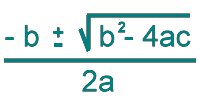Quadratic Equations

Any equation expressible of the form ax²
+ bx + c = 0 where a is not equal to zero is a quadratic
equation in x. A quadratic equation in x is an equation in
which the highest power of x is the second power. If an equation
is in the form given above, that is if it is written where all
nonzero terms are on one side and zero is on the other side, then
the quadratic is in standard form.
Methods of Solving Quadratic Equations:
- Factoring (Works on some but not all
quadratic equations.)
- Extraction of Roots (Works on
quadratic equations with no first degree term.)
- Completing the Square (Works for any
quadratic equation.)
- Quadratic Formula (Works for any
quadratic equation.)
Solving Quadratics by Factoring
Theorem: If ab = 0 either a = 0 or b = 0.
The above theorem is the basis for solving
quadratic equations by factoring.
To solve a quadratic equation by factoring
- Write the quadratic equation in
standard from.
- Factor the nonzero side of the
equation. (Remember not all quadratics factor.)
- Set factors equal to zero.
- Solve the two linear equations
obtained in the step above.
Examples:
- x² = 4 Write in standard form. x² -
4 = 0. Factor left side. (x = 2)(x - 2) = 0 Set factors
equal to zero. x + 2 = 0 or x - 2 = 0 Solve the
equations. x = -2 or x = 2 Express results as a solution
set. {-2,2}
- x² - 8x = -16 Write in standard form.
x² - 8x + 16 = 0 Factor left side. (x - 4)(x - 4) = 0
Set factors equal to zero. x - 4 = 0 or x - 4 = 0 Solve
the equations. x = 4 or x = 4 Express results as a
solution set. {4} Note there is only one distinct
solution.
- 10x² + 5x = 30 Write in standard
from. 10x² +5x - 30 = 0. Factor left side. 5(2x² + x -
6) = 0 Continue factoring left side. 5(2x - 3)(x + 2) = 0
Set factors equal to zero. Note first factor can not
equal zero. 2x - 3 = 0 or x + 2 = 0 Solve the equations.
2x = 3 or x = -2 x = 3/2 or x = - 2 Express answer as a
solution set. {3/2, -2}
A solution to an equation is also called a root
of the equation. Every quadratic equation has two solutions or
roots. The roots may or may not be distinct. In the second
example four is called a double root of the equation or a root of
multiplicity two since both roots of the equation are one and the
same.
Solving Quadratics by Extraction of Roots
A quadratic equation with no first degree
term can be solved easily by the extraction of roots method.
To solve a quadratic by the extraction of
roots method:
- Isolate second degree term on one side
of the equation.
- If coefficient of second degree term
is not one, divide both sides by the coefficient
- Take square root of both sides of the
equation. Remember every nonzero real number has two
square roots over the Complex field.
Examples:
x² - 36 = 0
x² = 36 (Isolate variable)
x = ± 6 (Extract roots.)
3x² - 125 = 0
3x² = 75 (Isolate variable)
x² = 25 (Divide by 3)
x = ± 5 (Extract roots.)
Solving Quadratics by Completing the
Square
Remark: Solving quadratic equations by
completing the square is a generalization of solving quadratic
equations by the extraction of roots method.
To solve a quadratic equation in a single
variable x by completing the square:
- Isolate the terms involving the x on
one side of the equation, constant on the other side.
- If coefficient of second degree term
is not one, divide each side of the equation by the
coefficient of second degree term.
- Complete the square. This is
accomplished by adding the square of 1/2 of the
coefficient of the first degree term to each side of the
equation.
- Factor the perfect square trinomial
thus obtained and combine constants on other side of the
equation.
- Extract roots.
- Solve for x.
Example:
2x² - 6x + 5 = 0
2x² - 6x = - 5 (Isolate variable)
x² - 3x = - 5/2 (Divide by coefficient of
second degree term)
x² - 3x + 9/4 = - 5/2 + 9/4 (Complete the
square)
(x - 3/2)² = -1/4 (Factor perfect square
trinomial and combine constants.
(x - 3/2) = + or - i/2 (Extract roots.)
Solving Quadratics Using the Quadratic
Formula
The roots of the quadratic ax² + bx + c =
0 are given by

To solve a quadratic using the quadratic
formula
- Write in the form ax² + bx + c = 0.
That is, write in standard form.
- Determine a, b, and c. the
coefficients of the second degree term, the first degree
term, and the constant term respectively.
- Substitute into the formula.
- Simplify radican first, then radical
if possible, and lastly reduce fraction if possible.
Remember to reduce a fraction the numerator must be in
factored form!
Example:
3x² + 4x = 2
3x² + 4x - 2 = 0 (Write in standard form.)
a = 3, b = 4, c = -2

Go back to equations
menu.
Go back to tutorial
menu.
Go back to home page.
Copyright © 1995 - Present. SSmyrl
|

